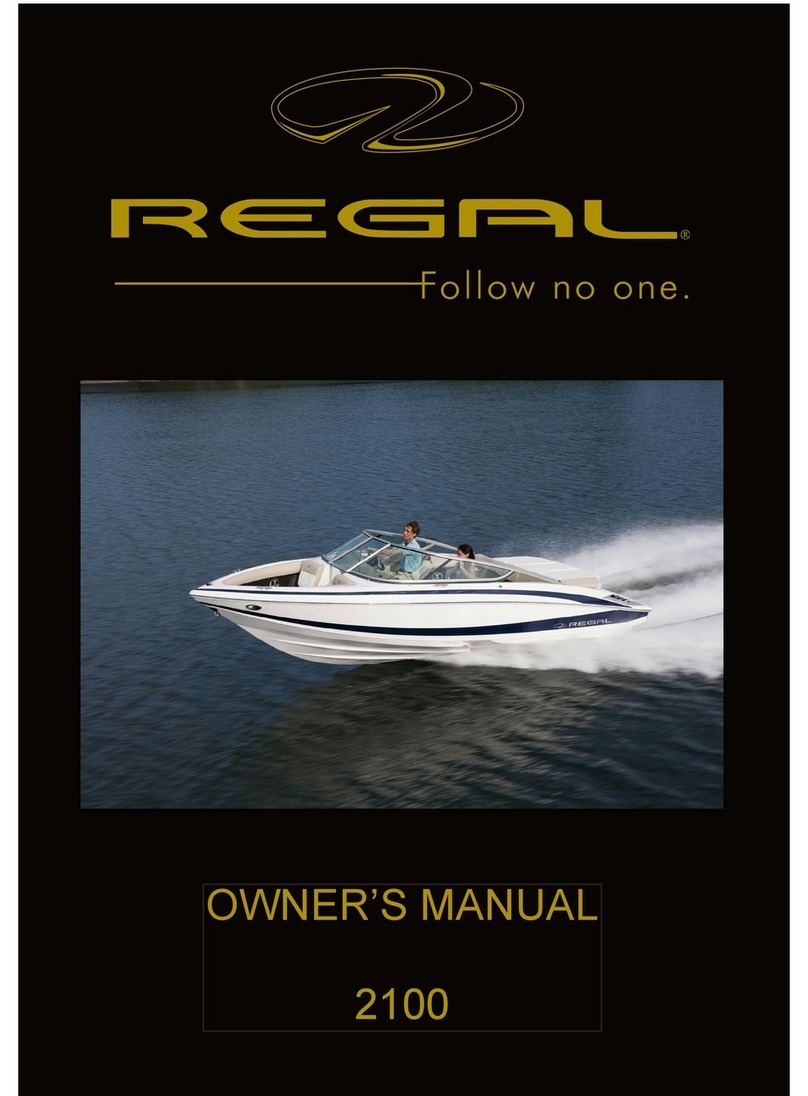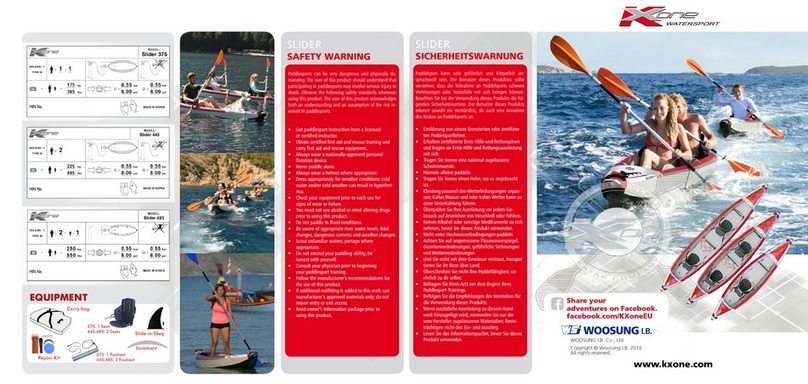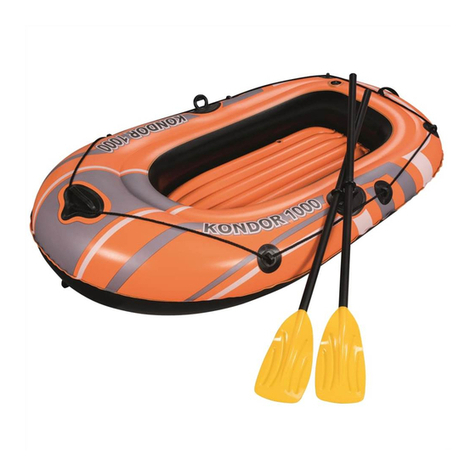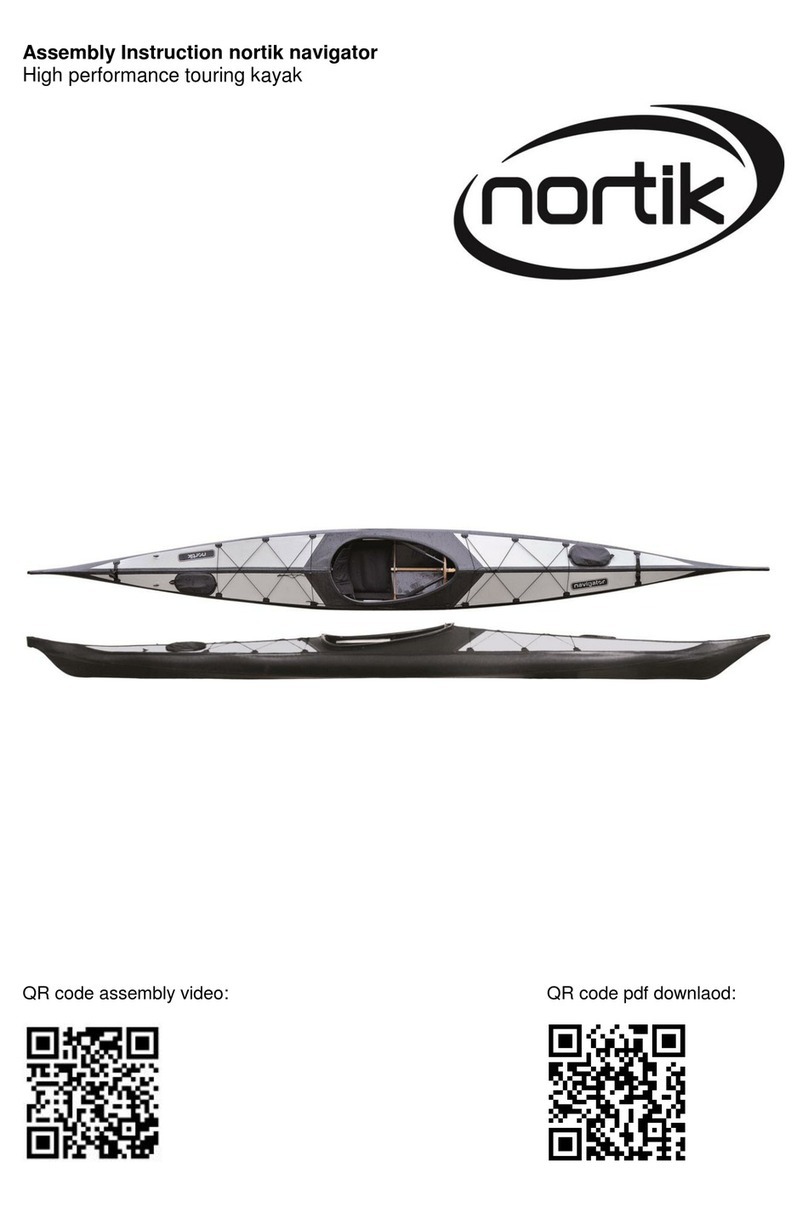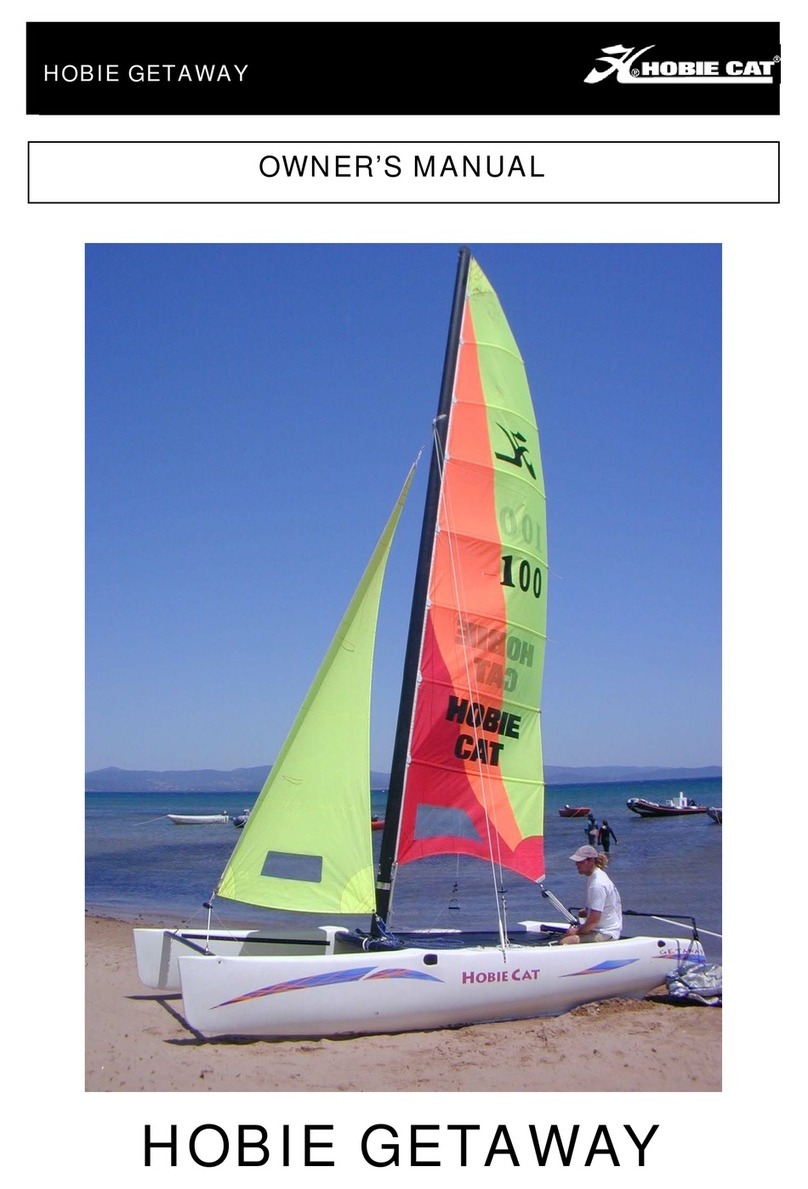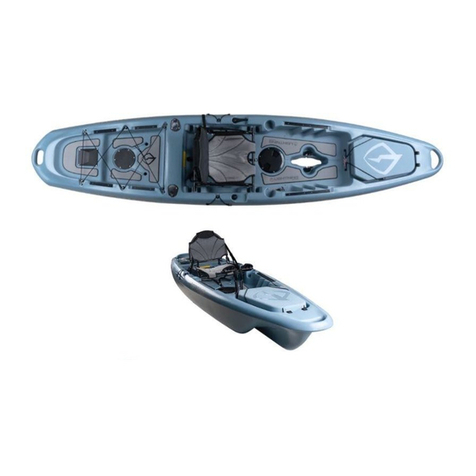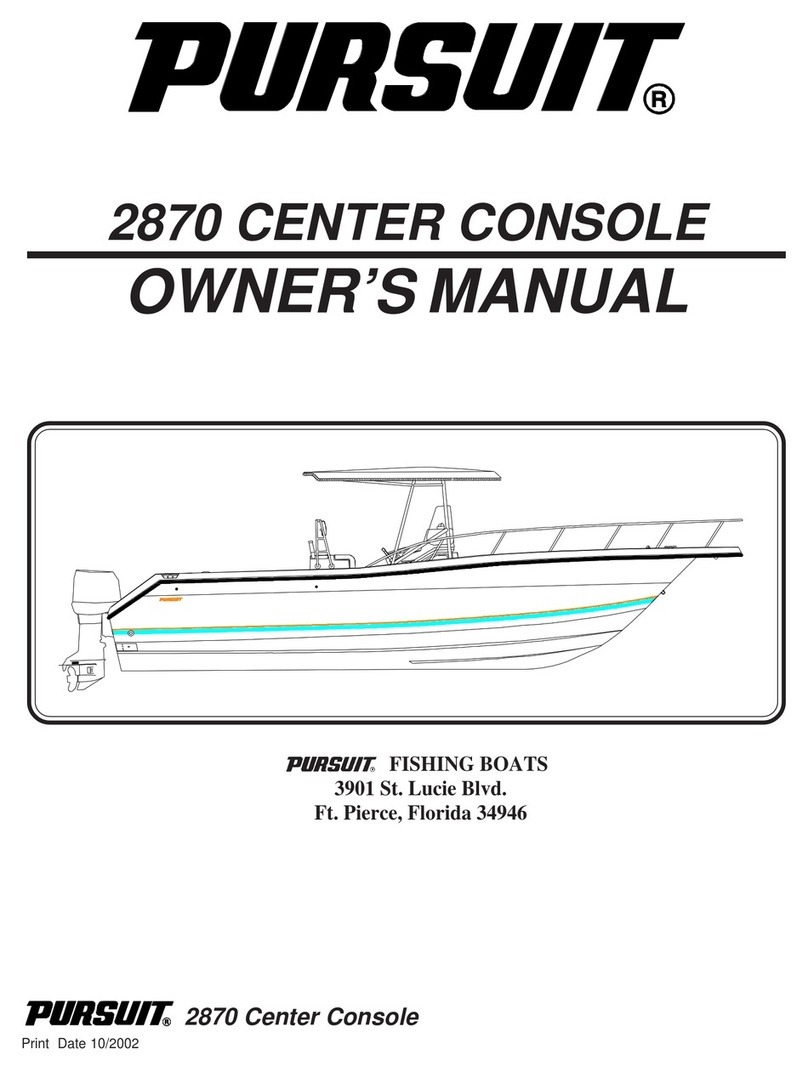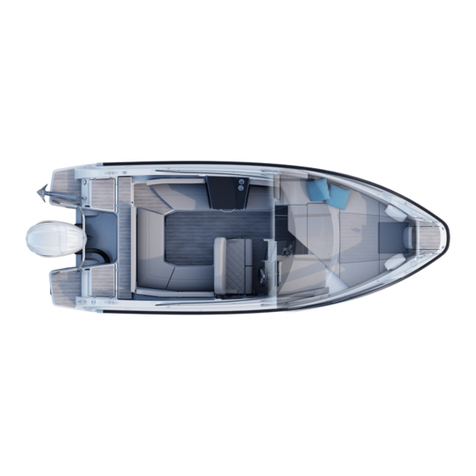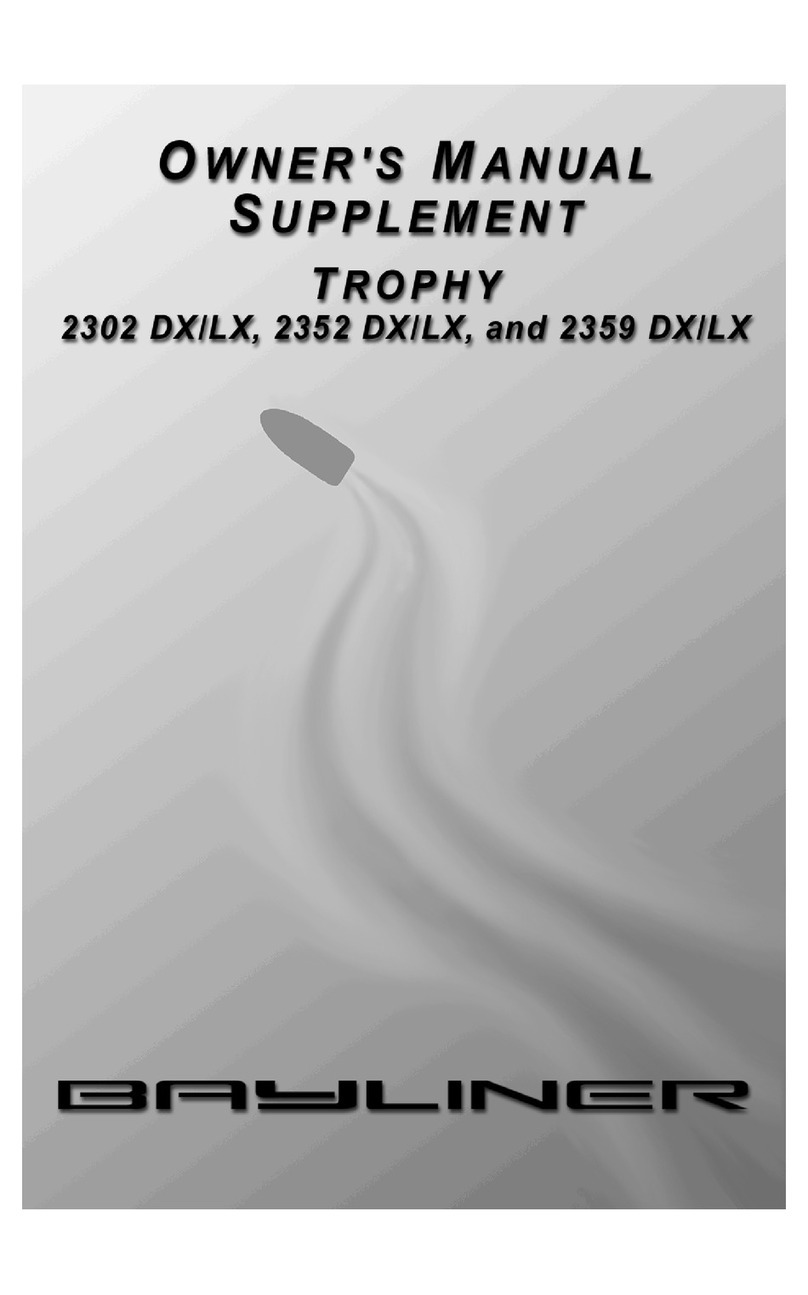AHPC CAPRICORN F18 User manual

CAPRICORN F18 OWNER’S MANUAL

Capricorn F18 Owner’s Manual v1.2 Page 2
Australian High Performance Catamarans Pty. Ltd. – 50 Craig Street – Bendigo – 3550 Australia
Phone: +61 3 544369910 – Fax: +61 3 54412963 – email: ahpc@ahpc.com.au – website: wwww.ahpc.com.au
AHPC CAPRICORN F18
OWNER’S MANUAL
Serial # ________________
Table of content
1. Introduction ........................................................................................................... 4
1.1. About this owner’s manual.................................................................................... 4
1.2. General information............................................................................................... 5
1.3. Information connected with the risk of flooding and stability................................. 5
1.3.1. Loading advice...................................................................................................... 5
1.3.2. Openings in the hull .............................................................................................. 5
1.3.3. Stability, Capsize and Recovery ........................................................................... 6
1.4. Recommendations and information for proper operation...................................... 6
1.4.1. Danger from overhead power lines and other obstacles....................................... 6
1.4.2. Towing on the water.............................................................................................. 6
2. Assembly............................................................................................................... 7
2.1. Glossary................................................................................................................ 7
2.2. Tools needed ........................................................................................................ 7
2.3. Arrival of goods..................................................................................................... 8
2.4. Capricorn F18 boat assembly............................................................................... 8
2.4.1. Hulls...................................................................................................................... 8
2.4.2. Beams................................................................................................................... 9
2.4.3. Trampoline............................................................................................................ 9
2.4.4. Mast .................................................................................................................... 10
2.4.5. Rigging................................................................................................................ 11
2.4.6. Raising the mast ................................................................................................. 12
2.4.7. Lowering the mast............................................................................................... 15
2.4.8. Spinnaker pole.................................................................................................... 15
2.4.9. Boom................................................................................................................... 17
2.4.10. Rudders............................................................................................................... 19
2.4.11. Centreboards ...................................................................................................... 20
3. Sailing ................................................................................................................. 21
3.1. Preparing to sail.................................................................................................. 21
3.1.1. Battens................................................................................................................ 21
3.1.2. Raising the main sail........................................................................................... 21
3.1.3. Lowering the main............................................................................................... 22
3.1.4. Setting the main sail............................................................................................ 22
3.1.5. Raising the jib...................................................................................................... 24
3.1.6. Raising the spinnaker.......................................................................................... 26
3.1.7. Beach trolley ....................................................................................................... 29
3.1.8. Launching............................................................................................................ 29
3.2. On the water........................................................................................................ 29
3.2.1. Recovery............................................................................................................. 29
4. Tuning................................................................................................................. 31
4.1. Platform............................................................................................................... 31
4.2. Rudder alignment................................................................................................ 31
4.3. Rig tension.......................................................................................................... 31
4.4. Mast rake ............................................................................................................ 32
4.5. Spreader rake ..................................................................................................... 32

Capricorn F18 Owner’s Manual v1.2 Page 3
Australian High Performance Catamarans Pty. Ltd. – 50 Craig Street – Bendigo – 3550 Australia
Phone: +61 3 544369910 – Fax: +61 3 54412963 – email: ahpc@ahpc.com.au – website: wwww.ahpc.com.au
4.6. Diamond tension................................................................................................. 32
4.7. Pre-bend ............................................................................................................. 33
4.8. Batten tension..................................................................................................... 33
4.9. General Sailing Philosophy of Catamarans ........................................................ 33
4.10. General settings.................................................................................................. 34
5. Maintenance........................................................................................................ 35
6. Transportation..................................................................................................... 36
7. Parts ................................................................................................................... 37
7.1. Lines specification Capricorn F18....................................................................... 37
7.2. Parts list Capricorn F18....................................................................................... 37
8. Warranty.............................................................................................................. 43
8.1. Warranty form ..................................................................................................... 43
8.2. Warranty description........................................................................................... 44
8.2.1. The Full Warranty Period.................................................................................... 44
8.2.2. The Pro-rata Warranty Period............................................................................ 44
8.3. Warranty conditions ............................................................................................ 44
8.3.1. This Warranty is provided on the following conditions........................................ 44
8.3.2. Exclusions, this Warranty does not cover........................................................... 45
8.3.3. Operation Limitations.......................................................................................... 45
8.3.4. Limitations........................................................................................................... 45
8.3.5. Responsibilities................................................................................................... 45
8.3.6. Voided warranty.................................................................................................. 45

Capricorn F18 Owner’s Manual v1.2 Page 4
Australian High Performance Catamarans Pty. Ltd. – 50 Craig Street – Bendigo – 3550 Australia
Phone: +61 3 544369910 – Fax: +61 3 54412963 – email: ahpc@ahpc.com.au – website: wwww.ahpc.com.au
1. Introduction
Congratulations with your new Capricorn F18. We were delighted creating the Capricorn F18. It
has exceeded all our expectations; and when we see people's reactions after their first sail we
know, they too, are delighted with it.
Greg Goodall
Managing Director
Australian High Performance Catamarans Pty. Ltd.
1.1. About this owner’s manual
This manual has been compiled to help you operate your Capricorn F18 catamaran with safety and
pleasure. It contains details of the boat and equipment fitted. Please read it carefully and
familiarize yourself with the boat before using it.
Please ensure that you are able to handle the catamaran in the anticipated wind and sea
conditions before venturing out. This craft has been classified (in Australia) as a category C vessel,
meaning a boat designed to operate in winds up to force 6 on the Beaufort scale and associated
wave heights.
This owner’s manual is not a course on boating safety or seamanship. If this is your first beach
catamaran, or if your unfamiliar with it, please ensure you obtain handling experience before
“assuming command” of the boat. Your dealer, National Sailing Federation or Yacht Club will be
pleased to advice you of local sailing schools, or competent instructors.
This owner’s manual is not a detailed maintenance or trouble shooting guide. In case of difficulties,
always refer to APHC or its proper representative.
Always use trained and competent people for maintenance, fixing and modifications of your
Capricorn F18. APHC cannot be held responsible for modifications they have not approved.
Note also that any change in the disposition of masses aboard may significantly affect the stability,
trim and performance of your boat
Users of the boat are advised that:
♦All crew should receive suitable training.
♦The boat should not carry more than the manufacturer’s recommended load.
♦Stability is reduced by any weight added high up.
♦Hatches must be sealed before leaving the shore
♦Breaking wave are a serious stability hazard
♦Buoyancy aids are recommended to wear at all times by all crew for their own safety.
In some countries, a driving licence or authorisation may be required, or specific regulations might
apply. Please familiarize yourself with these.
Always maintain your boat properly and make allowance for the deterioration that will occur in time
and as a result of heavy use or misuse of the boat.

Capricorn F18 Owner’s Manual v1.2 Page 5
Australian High Performance Catamarans Pty. Ltd. – 50 Craig Street – Bendigo – 3550 Australia
Phone: +61 3 544369910 – Fax: +61 3 54412963 – email: ahpc@ahpc.com.au – website: wwww.ahpc.com.au
Any boat, how strong it may be, can be severely damaged if not used properly. This is not
compatible with safe boating.
Please keep this owner’s manual in a safe place and hand it over to the new owner when you sell
the boat.
1.2. General information
Manufacturer: Australian High Performance Catamarans Pty. Ltd. (AHPC)
Model: Capricorn F18
Category C: A boat designed to operate on winds up to force 6 on the Beaufort scale and
associated wave heights (significant waves up to 2 metres) Such conditions may be
encountered on exposed inland water, in estuaries and in coastal waters in moderate
weather conditions.
A significant wave height is the mean height of the highest one third of the wave, which
approximately corresponds to the wave height estimated by an experienced observer.
Some waves will be double this height.
Maximum Recommended Load: bx 2
b+ b+ luggage = 200 kg.
Specifications:Length (LH1) = 5,5 metre
Width (BH1) = 2,6 metre
Mast height = 9,1metre
Main sail area = 15.3 m2
Jib area (optional) = 4,15 m2
Mast area = 1,7 m2
Spinnaker area = 21 m2
Maximum draft = 1.250 mm with centre boards down
Maximum draft = 250 mm with centre boards and rudders up
Weight fully rigged = 180 kg
Identification: Hull identification number on stern of each hull.
1.3. Information connected with the risk of flooding and stability
1.3.1. Loading advice
Keep the total weight of provisions, miscellaneous equipment not supplied by the manufacturer
and persons aboard below the Maximum Recommended Load and suitably distributed.
1.3.2. Openings in the hull
Hatch covers in the stern and deck must be sealed before leaving the shore. When storing the boat
ashore, be sure to have the holes covered and it may be wise to leave the hatches open for
ventilation purposes.

Capricorn F18 Owner’s Manual v1.2 Page 6
Australian High Performance Catamarans Pty. Ltd. – 50 Craig Street – Bendigo – 3550 Australia
Phone: +61 3 544369910 – Fax: +61 3 54412963 – email: ahpc@ahpc.com.au – website: wwww.ahpc.com.au
1.3.3. Stability, Capsize and Recovery
This boat is intended to be recovered after a capsize by the crew. The minimum crew weight
needed is 130 kg. When using the correct technique, the wind that aides in your capsize, will also
assist you in the recovery. See for the proper technique the Recovery chapter later n this Owner’s
Manual.
1.4. Recommendations and information for proper operation
1.4.1. Danger from overhead power lines and other obstacles
When rigging and moving your boat, please look up and inspect the overhead area. Observe the
location of overhead power lines and trees. These obstacles can damage your boat are potentially
dangerous to yourselves
1.4.2. Towing on the water
When towing is required, make sure that:
♦The tow rope is secure around the mast foot or mast step.
♦The boat is towed at a low speed.
♦The tow line is fastened in such a way, that it can be released when under load
♦The tow line is of sufficient length to manoeuvre safely.

Capricorn F18 Owner’s Manual v1.2 Page 7
Australian High Performance Catamarans Pty. Ltd. – 50 Craig Street – Bendigo – 3550 Australia
Phone: +61 3 544369910 – Fax: +61 3 54412963 – email: ahpc@ahpc.com.au – website: wwww.ahpc.com.au
2. Assembly
2.1. Glossary
Aft: Back of the boat.
Bow: Front of the boat.
Batten: Thin strip which fits into a long narrow pocket in the sail. It will give the sail its shape.
Bridle wire: One of the two wires connected to the bow and forestay.
Boom: Spar at the foot of the sail.
Centre board: A retractable plate that that reduces sideway drift. Also known as dagger board.
Cleat: Fitting used for holding / securing ropes.
Clew: Lower most after-most corner of a sail.
Crossbar: Bar that connects the rudders on each hull.
Dolphin striker: Load bearing strap under the front beam.
Downhaul: Rope to stretch the luff of the sail. Also referred to as Cunningham.
Foot: Bottom edge of the sail.
Forestay: Wire supporting the mast in the fore and aft direction.
Gunwale: Outermost edge of the hull.
Goose neck: A hinge fitting connecting the boom to the mast.
Halyard: Rope or wire used to lower or hoist sails
Head: The top corner of the sail.
Hound: Point where the stays are connected to the mast
Jib: Front sail.
Jib Sheet: Control rope for the jib.
Leeward: The side of the boat the sails are set to when sailing.
Leech:Trailing edge of the sail.
Luff: Front edge of the sail.
Main sheet: Rope controlling the position of the main sail.
Mast rake: Angle of the mast to the hull.
Mast step; Fitting on the boat where the mast is connected to the front beam.
Pintel: Fitting on the transom and rudder used to hang.
Rudder stock: Carrier of a rudder blade and has an arm to steer.
Shackle: U-shaped metal strip with a pin to secure halyards etc.
Shrouds: Wire supporting the mast in the lateral direction.
Spinnaker: Isometric sail hoisted when sailing downwind.
Spinnaker pole: the pole, which extends to fly the spinnaker.
Spreaders: Metal struts placed in pairs to support the mast control the bend in the mast.
Stamaster: Adjustable stay connector to chain plate.
Stern: Back of the boat.
Tack: Forward lower corner of the sail.
Tiller: (Telescopic) rod connected to the cross bar to steer the boat.
Traveller: Track running side to side on which the main sheet is attached.
Transom: Flat vertical plane of the end of the hull.
Trapeze: Wire to extend the body beyond the gunwale.
Windward: The side of the boat opposite to where the sails are set to when sailing.
2.2. Tools needed
Your Capricorn F18 can be assembled without an expensive tool kit, but be advised to have ready
with you the following tools:
♦Sharp knife

Capricorn F18 Owner’s Manual v1.2 Page 8
Australian High Performance Catamarans Pty. Ltd. – 50 Craig Street – Bendigo – 3550 Australia
Phone: +61 3 544369910 – Fax: +61 3 54412963 – email: ahpc@ahpc.com.au – website: wwww.ahpc.com.au
♦Cross head screw driver Philips #2
♦Small screwdriver
♦7 mm ring spanner
♦17 mm ring spanner or preferably a hexagonal socket
♦24 mm open spanner
♦Torque wrench (optional)
♦Pop rivet tool
♦Shackle tool
♦Tape measure
♦Duralac sealant (anti corrosive paste)
♦A roll of tape for split rings
2.3. Arrival of goods
A typical shipment directly from AHPC would involve in average about 3 cardboard boxes and 1
long package in which the entire catamaran can be transported:
♦2 Long card board boxes containing a hull each.
♦1 Shorter cardboard box for the beams, sail, boom, foils and rudder stocks.
♦1 Single long package for the mast, depending on the way of shipment this might also be a
steel crate.
Should your boat have come through a local dealer, most of the assembly work has probably
already been done for you, but still take this manual as a reference for building up and dismantling
your Capricorn F18 when transporting and storing.
2.4. Capricorn F18 boat assembly
2.4.1. Hulls
Place the 2 cardboard boxes that contain the hulls parallel on a flat surface approximately 2 metres
apart and cut the top part open. The sides of the boxes may be folded down to have a clean and
protective working surface. The 2 cardboard frames per box should keep the hulls upright. Mind
you, those dry cardboard boxes can be slippery.

Capricorn F18 Owner’s Manual v1.2 Page 9
Australian High Performance Catamarans Pty. Ltd. – 50 Craig Street – Bendigo – 3550 Australia
Phone: +61 3 544369910 – Fax: +61 3 54412963 – email: ahpc@ahpc.com.au – website: wwww.ahpc.com.au
2.4.2. Beams
The beams are ready to go onto the boat, all beam bolts are numbered for their position in the
beams.
♦Make sure that the rear and front beam are facing the correct way. On the rear beam the
eyelets for the traveller cord should be facing backwards. Apply sufficient grease to the
threaded part of all bolts before inserting them into the hull. Get all the bolts started before
tightening the 1st bolt. Be careful not to over tighten or cross thread the bolts. If a particular
bolt is being difficult to fit then fit this bolt first.
♦Use a 17 mm hexagonal socket or a 17 mm spanner to tighten the bolts properly. The bolts
should be set to 20Nm using a torque
wrench.
♦In case a torque wrench is not at hand,
a weighing clock (as used in fishing for
instance) connected to a 17 mm ring
spanner will do the job too. If the ring
spanner would have an effective length
of 0, 15 m, the clock should read 13.5
kg for 20Nm.
♦Do not forget to check the bolts from
time to time as some setting will occur
during the firsts boating. In no case
exceed the recommended 20 Nm as
over tightening will result in a damaged
threads
♦Finally, after the platform has been assembled, the dolphin striker needs to be tensioned.
Use a 24 mm spanner to extent the pole between the front beam and the striker strap. The
centre of the front beam should be 10 mm higher then on the ends. The front beam is then
bent up and slightly pre-stressed.
2.4.3. Trampoline
Fitting the trampoline might take some effort as it new and has not yet been stretched from use.
♦The trampoline should already be attached to the front beam. If not slide it into the front
beam groove and refit the front beam end plate.
♦Fold the trampoline upwards and insert the cords on either side in the track of the hull.
Adding a little Teflon or silicon base lubricant to the track and on the cord of the trampoline
will ease the work considerably.
♦Slide the trampoline down the track on each hull. This is best done with 1 person on either
side of the platform and does require some care to pull the trampoline backwards. Keep it
even on each side as it moves down the hulls. You may need to help feed the tramp into the
track once it pulls tight across the boat. Finally slide the alloy tube into the pocket at the rear
end.
♦Use the 3mm cord to lace the tramp to the rope buttons on the rear beam. Pull very tight as
you move across the boat. Use the rope buttons on the rear beam to absorb the surplus
length of the cord after tensioning.
♦The shock cord for the skipper’s trapeze wires should pass underneath all other lines and
around the striker post.
♦The righting rope should be attached to the front beam by passing outwards through a
saddle on either side with a stop knot and kept tight and flat in a V-shape backwards under
the trampoline by a shock cord running from the front beam, through an shackle at the rear of
the tramp. In this way, sufficient righting line is always available without having it on deck.

Capricorn F18 Owner’s Manual v1.2 Page 10
Australian High Performance Catamarans Pty. Ltd. – 50 Craig Street – Bendigo – 3550 Australia
Phone: +61 3 544369910 – Fax: +61 3 54412963 – email: ahpc@ahpc.com.au – website: wwww.ahpc.com.au
♦On the trampoline, toe straps have been provided, running from the front beam to the rear
beam. Fold the outer edges of the loop at its end inwards for more strength and tie the toe
straps to the saddles on the rear beam using a half hitch on the strings not dissimilar to tying
the battens. Secure the loose ends by adding another reef knot on the half hitch. Check the
tension from time to time. Some like it to be taut; others prefer it to be slack.
2.4.4. Mast
The mast supplied from your local dealer will be fully fitted out ex works. If the mast has been
shipped to you some fittings may be required to be fitted to complete the mast. All holes are
predrilled and all components and rivets are supplied. Please, fit all the items first and go sailing
with the factory settings before attempting any adjustment. Factory settings are set out in the
tuning guide. Familiarize yourself with the boat and it’s characteristics before making any
adjustment whatsoever.
♦If not already fitted, the mast requires the mast spanners to be riveted in place. The required
pop rivets should have been taped to the spanner. Apply some Duralac or anti corrosive
paste on the facing surfaces and some as well on the head of the rivet before inserting. This
will prevent electrolytic corrosion of the different metals due to (salt) water creeping in.
♦Then get the spreaders on and when fitted correctly, they should be pointing backwards, in
the direction of the sail track. Fit the spreader in their respective brackets and secure the
locknuts at the front using a 7 mm spanner and secure the split rings at the back using a
piece of tape. Note that the spreaders are set to standard length.
♦Connect the diamond wires to the mast, if not already pre-assembled and set to a standard
tension.
♦Now it is time to fit the diamond wires to the spreaders. The mast should lie flat and put your
feet at one side of the mast at either side of the spreader. In order not to damage the mast, it
is wise to take off your shoes or cover up the mast. Pull back the diamond wire until it
Anti-foul loop
Rake adjusters
Spreader arm

Capricorn F18 Owner’s Manual v1.2 Page 11
Australian High Performance Catamarans Pty. Ltd. – 50 Craig Street – Bendigo – 3550 Australia
Phone: +61 3 544369910 – Fax: +61 3 54412963 – email: ahpc@ahpc.com.au – website: wwww.ahpc.com.au
notches onto the spreader. Secure the
diamond wire by screwing on the cap of the
spreader, but do not tighten yet.
♦Go over to the other side. You will notice this
takes considerably more strength as one
side of the mast has been stiffened by the
first diamond wire. Repeat notching over the
diamond wire and screw on the cap. Make
sure the spreaders are perpendicular to the
face of the mast.
♦Adjust the diamond tension as set out in the
tuning guide.
♦If necessary, fit the mast rotator arm. The holes have been predrilled on the mast and the
rivets have been taped to the piece itself. Apply some Duralac or silicone kit to the facing
surfaces and rivets, before tightening the rotator arm with the 4 rivets. Off course the arm
should face backwards when fitted.
2.4.5. Rigging
With the mast still lying flat, sail track down, roll out the stays and trapeze wires to be fitted.
♦The 2 side stays and the 1 forestay must be fitted to the bottom eye of the hound at the
upper mast part. Use the large shackle to connect the lower eye. Keep the shackle centred
and upright by adding washers left and right along the pin. Assure yourself that the fore stay
is in the middle of the 2 side stays.
Cap
Spreader length adjustment

Capricorn F18 Owner’s Manual v1.2 Page 12
Australian High Performance Catamarans Pty. Ltd. – 50 Craig Street – Bendigo – 3550 Australia
Phone: +61 3 544369910 – Fax: +61 3 54412963 – email: ahpc@ahpc.com.au – website: wwww.ahpc.com.au
♦Fit the trapeze wires to the top eye using the smaller shackle. Here too, washers may be
used to keep the shackle upright.
♦The side stays have Stamaster adjusters, to fit the chain plates of the hulls near the front
beams. The front stay attaches to the bridle plate and via 2 bridles to the chain plates at the
bows. Make sure the bridles are connected to the chain plates at the bows using the
shackles, before raising the mast and in such a way, the bridle plate can be held upwards
without a twist.
♦Do not forget to secure all shackles with a set of pliers or appropriate shackle tool.
2.4.6. Raising the mast
The usual procedure is to raise the mast from the back of the boat. In this case, it might be helpful
to have the sterns facing windward, making raising the mast easier. Also height differences in
terrain condition may be used to good advantage.
The hinged mast step allows the mast to be raised and lowered from any direction. The key to this
is that the front of the mast must face the direction that it is to be raised from, or lowered to.
Raising the mast requires minimal 2 persons. The usual procedure would be:
♦Put the assembled platform on a flat surface, preferably with its sterns windward.
♦Raise the mast from the back of the boat.
♦Position the mast on the boat, sail track down, with the base of the mast just forward of the
main beam and the top of the mast out the stern.
♦Connect the side stays to the corresponding chain plates, with the Stamaster adjusters at
maximum length. Rigging the 1st time the Stamaster will be fitted permanently to the chain
plates, so the next time the mast is raised, only the flat threaded part my be inserted to the
nut.
Sail track down for connecting stays

Capricorn F18 Owner’s Manual v1.2 Page 13
Australian High Performance Catamarans Pty. Ltd. – 50 Craig Street – Bendigo – 3550 Australia
Phone: +61 3 544369910 – Fax: +61 3 54412963 – email: ahpc@ahpc.com.au – website: wwww.ahpc.com.au
♦Keep the trapeze wires loose and untangled. `
Mast step and
pin
Trapeze wires
Sail track up for raising the mast
Hinge pin in mast step

Capricorn F18 Owner’s Manual v1.2 Page 14
Australian High Performance Catamarans Pty. Ltd. – 50 Craig Street – Bendigo – 3550 Australia
Phone: +61 3 544369910 – Fax: +61 3 54412963 – email: ahpc@ahpc.com.au – website: wwww.ahpc.com.au
♦Turn the mast over, sail track up, and connect the base of the mast to the mast step using
the hinge pin trough the aligned holes of both mast foot and mast step.
♦Walk the mast up from the stern. At the same time the 2nd person should be pulling the mast
up using one of the trapeze wires.

Capricorn F18 Owner’s Manual v1.2 Page 15
Australian High Performance Catamarans Pty. Ltd. – 50 Craig Street – Bendigo – 3550 Australia
Phone: +61 3 544369910 – Fax: +61 3 54412963 – email: ahpc@ahpc.com.au – website: wwww.ahpc.com.au
♦When the mast is vertical allow the mast to rotate so that sail groove now faces backwards.
♦Hold the mast upright with one of the trapeze wires while the forestay is connected to the
forestay bridle.
♦Set the front stay to the appropriate hole on the bridle tube for the required mast rake.
♦Adjust the Stamasters to tighten the rig properly.
♦Take out the hinge pin from the mast step.
♦Connect the trapeze wires to their shock cords.
2.4.7. Lowering the mast
This is basically the reverse as raising the mast:
♦Put the mast step hinge pin in place.
♦Remove the boom and spinnaker pole first.
♦Lessen the tension on the side stays.
♦Undo at least on trapeze wire.
♦Use that trapeze wire to pull the mast forward, releasing pressure on the pin at the bridle
tube.
♦Turn the mast around so that the front side is facing the direction in which the mast will be
lowered.
♦Gently ease the trapeze wire to slacken the side stays. Stand on the trampoline to lower the
mast down, since at a certain point the mast cannot be held by the trapeze wire alone. Be
careful not to drop the mast on the track of the rear beam.
♦Undo the remaining trapeze wires and take the Stamasters apart.
2.4.8. Spinnaker pole
The spinnaker pole may require the snuffer ring to be riveted in place if the boat has not been
supplied from your local Dealer. The pole and ring have been predrilled and the required pop rivets
should have been taped to the ring.
♦Put the spinnaker bag over the spinnaker
pole using the sewn in pockets and slide the
chute into the groove of the ring if it has not
been done already by the factory.
♦Fit the spinnaker pole to the front beam
using the pin and retainer clip. Make sure
the pin also secures the halyard block at the
base of the spinnaker pole. Connect the
front braces to the bow at the required
length, indicated by the luff length of the
spinnaker itself and the preferred height of
the spinnaker pole tip. Assure that both
braces have the same working length and
that the loop is shorter than the tail with its
end knot. Under tension the loop will be tightened, not the tail over the bow tip. Pass the loop
in the end of the brace through the hole in the bow and the rope tail then passes through the
loop on the outside to prevent the loop coming out of the bow holes.
♦Lift the centre of the spinnaker pole and run the support line from the bridle plate under the
spinnaker pole, it will bend slightly upwards. Make sure the small s-hook cannot jump of the
bridle plate.
Groove
Spinnaker pole

Capricorn F18 Owner’s Manual v1.2 Page 16
Australian High Performance Catamarans Pty. Ltd. – 50 Craig Street – Bendigo – 3550 Australia
Phone: +61 3 544369910 – Fax: +61 3 54412963 – email: ahpc@ahpc.com.au – website: wwww.ahpc.com.au
♦Connect the 2 shock cords at the end of the chute to the loops under the trampoline. This
should keep the chute taught.
Loop
Tail
Knot
2 mm line
from
chainplate to
ring
2 mm line from
pole to ring
Front brace

Capricorn F18 Owner’s Manual v1.2 Page 17
Australian High Performance Catamarans Pty. Ltd. – 50 Craig Street – Bendigo – 3550 Australia
Phone: +61 3 544369910 – Fax: +61 3 54412963 – email: ahpc@ahpc.com.au – website: wwww.ahpc.com.au
♦Run the rear 2 mm cord from the ring to corresponding bridle chain plate and lead the other 2
mm cord forward to close the gap between the ring and the pole.
♦Turn the boat onto its side to access the top block of the spinnaker halyard.
♦Tie one end of the 3.0mm Dyneema halyard to the top eye of the fore stay.
♦Feed on the double ended halyard block onto the halyard and then take the free end and
pass it through the top spinnaker halyard block on the mast.
♦Tie the halyard temporarily to the spinnaker ring.
♦Take the 4mm Spectra halyard cord coming out of the block at the base of the spinnaker
pole and pass it through the anti-foul loop at the diamond arms. Next pass it through the free
half of the double-ended halyard block and back down through the anti-foul loop and cleat off
the halyard on the halyard cleat on the side of the mast.
♦Now feed the halyard end from the cleat through the pulley on the front of the tramp.
♦Continue the spinnaker halyard through to a shock cord tensioned retaining ring and back
through another small deck block into an oval aperture of the trampoline. This part of the
halyard will be now be the retrieval line.
♦Grab the retrieval line underneath the trampoline and feed it through the eyelet in the
spinnaker chute where it should exit the ring on the spinnaker pole.
♦Tie it of temporarily to the ring.
♦Now right the boat.
2.4.9. Boom
To be attached to the mast is the boom, holding the main outhaul and the mast rotator line.
S-hook
Support line

Capricorn F18 Owner’s Manual v1.2 Page 18
Australian High Performance Catamarans Pty. Ltd. – 50 Craig Street – Bendigo – 3550 Australia
Phone: +61 3 544369910 – Fax: +61 3 54412963 – email: ahpc@ahpc.com.au – website: wwww.ahpc.com.au
♦Insert the block onto the goose neck and put the pin through the holes, from top to bottom.
Secure the pin with the retaining clip. To keep the clip from getting lost, secure it with a small
line to an object on the mast.
♦Out of the mast rotator arm comes a line that passes through a small block. Connect that
small block to the saddle on the underside of the boom. When attaching, give sufficient slack
to move the boom freely. The mast rotator lines should be coming out of swivel cleats on
either side of the mast.
♦The strap for the main sail and main sheet is a tight fit over the outhaul.
Rotator arm
Goose neck

Capricorn F18 Owner’s Manual v1.2 Page 19
Australian High Performance Catamarans Pty. Ltd. – 50 Craig Street – Bendigo – 3550 Australia
Phone: +61 3 544369910 – Fax: +61 3 54412963 – email: ahpc@ahpc.com.au – website: wwww.ahpc.com.au
2.4.10. Rudders
Rudder stocks are uniquely starboard and port. When fitted correctly the rudder stocks should face
inwards in the direction of the mast.
♦Lubricate the transom pintels and bushes in the rudderstocks with silicon spray.
Clew
Main sail strap Toe strap

Capricorn F18 Owner’s Manual v1.2 Page 20
Australian High Performance Catamarans Pty. Ltd. – 50 Craig Street – Bendigo – 3550 Australia
Phone: +61 3 544369910 – Fax: +61 3 54412963 – email: ahpc@ahpc.com.au – website: wwww.ahpc.com.au
♦Place the stocks onto the pintels at the transom. Make sure the lock plates snap over the
casting and if safety requirements require it, fit the retaining clips on the bottom pins as well.
♦The cross bar has easy connectors for a quick assembly. Make sure the easy connector for
the tiller extension is facing upwards/frontward.
♦Attach the tiller extension to the cross bar using the easy connectors.
♦Make sure to keep the rudder blades in the protective covers during transportation and
storage.
2.4.11. Centreboards
Both centreboards are essentially the same, but the strap fitted to them makes them starboard and
port. The straps should have the retainer knot on the outside of the boat, when fitted. Always make
sure that you push and lift the centre board perpendicular to the face of the hull.
♦Before putting the centreboards in their casing, rinse the felt lining with water to get rid of
sand and other stuff that might damage the board when pushing it down in a dry condition.
♦Put the centre board in corresponding hulls and slide it downwards. The felt will retain the
board in its position.
♦The strap connecting the centerboards should pass under the toe straps and all other lines
on the tramp deck. Pulling the strap will raise the boards from either side of the boat.
♦Make sure to keep the centreboards in the protective covers during transportation and
storage.
Easy connectors
Pintels
Table of contents
